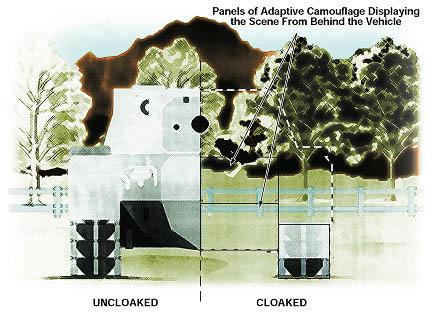|
Cloaking Technology |
|
|
..
NASA's Jet Propulsion Laboratory, Pasadena, California
Lightweight optoelectronic systems built around advanced image sensors and display panels have been proposed for making selected objects appear nearly transparent and thus effectively invisible. These systems are denoted "adaptive camouflage" because unlike traditional camouflage, they would generate displays that would change in response to changing scenes and lighting conditions. Image;
A typical adaptive camouflage system would likely include a network of flexible electronic flat-panel display units arrayed in the form of a blanket that would cover all observable surfaces of an object that one seeks to cloak. Each display panel would contain an active-pixel sensor (APS) [or possibly another advanced image sensor] that would look outward from the panel through an aperture that would occupy only a small fraction of the area of the panel. The blanket would also contain a wiring harness that would include a cross-connected fiber-optic network, through which the image from each APS would be transferred to a complementary display panel on the opposite side of the cloaked object. The positions and orientations of all the image sensors would be slaved to the position and orientation of one image sensor that would be designated a master imager. The orientations would be determined by a levelling instrument sensed by the master imager. A central controller connected to an external light meter would automatically adjust the brightness levels of all the display panels to make them conform to the to ambient lighting conditions. The underside of the cloaked object would be illuminated artificially so that the display from the top of the cloaked object would show the ground as though in ambient light; if this were not done, then an obvious shadow-induced discontinuity would be seen by an observer looking down from above. The display panels could be sized and configured so that a common inventory of such panels could be used to cloak a variety of objects, without need to modify the objects. Sizes and weights of representative adaptive camouflage systems and subsystems have been estimated: The volume of a typical image sensor would be less than about 1 in.3 (? 16 cm3). A system to completely cloak an object 10 m long by 3 m high by 5 m wide would weigh less than about 100 lb (? 45 kg). If the object to be cloaked were a vehicle, then the adaptive camouflage system could readily be operated on power provided by the vehicle electrical system, without adversely affecting the operation of the vehicle. The Scene From Behind an Object would be displayed on panels on the front of the object. The effect of cloaking is illustrated in this simulated image of an armored vehicle with adaptive camouflage on one side only. This work was done by Philip Moynihan of Caltech and Maurice Langevin of Tracer Round Associates, Ltd., for NASA's Jet Propulsion Laboratory. For further information, access the Technical Support Package (TSP) free on-line at www.nasatech.com under the Electronic Components and Systems category. |
|
| FAIR USE NOTICE: This page contains copyrighted material the use of which has not been specifically authorized by the copyright owner. Pegasus Research Consortium distributes this material without profit to those who have expressed a prior interest in receiving the included information for research and educational purposes. We believe this constitutes a fair use of any such copyrighted material as provided for in 17 U.S.C § 107. If you wish to use copyrighted material from this site for purposes of your own that go beyond fair use, you must obtain permission from the copyright owner. | |
|
|

